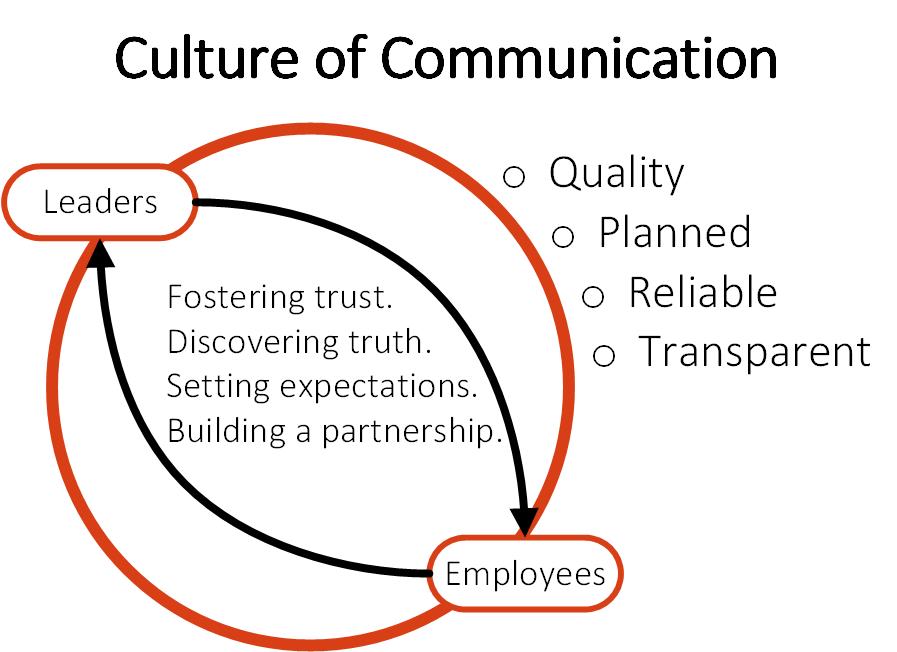Creating a Culture of Communication
Posted on July 25, 2018 by Jonathan Mills
Every organization is susceptible to experiencing the unexpected; because communication, which we often take for granted, can turn temporary hardship into a costly crisis. As an example, consider Average Joe’s Company. They have experienced recent growing pains: acquisition of another firm, graduation from the 8A program, and the loss of several client contracts; but Joe’s has had historically ineffective communication practices. So, when the executive team starts hearing murmurs and some of their best employees quit, it isn’t clear why. Even though HR has undertaken a few efforts to understand these issues (stay interviews, team restructuring, and a leadership development program), the situation is getting worse. The executive team is worried and frustrated because none of their communication efforts have been fruitful, and these temporary problems are quickly becoming a serious crisis.
Crises are impossible to resolve without good communication, but effective communication is never turnkey. Average Joe’s needs to bridge the gap with their employees, but how? Communication is a complex cultural dynamic. It consists of more than just the logistics of disseminating information, including a powerful relational element. This relationship between leadership and their employees determines the quality of communication, affecting truthfulness, accuracy, and helpfulness. If a prior relationship was not established when a crisis arrives, then any knee-jerk efforts to improve communication are likely to fail.
The best time to foster good communication is before the crisis arrives, but if you are already struggling there is still short-term progress to be made. Focus on improving your relationships through policy and practice. Critically evaluate your new and existing activities against the below criteria. If your employees see that sincere changes are being made, it will restore some of their lost trust and confidence. For longer-term benefits, consider your overall communication strategy. If it doesn’t meet the following standards then you need make adjustments.
1 Quality
Foster the connection between messenger and recipient.
Quality communication improves the relational connection between the messenger and recipient. It is substantive, sincere, and interpersonal. Optimally, there is a “one-on-one” interaction between executive leaders and each level of the organization. This is an opportunity to humanize leadership in employee’s eyes by creating mutual understanding.
2 Planned
Establish a consistent and balanced schedule.
Most communication should be scheduled far in advance with a predetermined agenda. It should be frequent enough that employees don’t feel disconnected, but not so frequent that they feel overwhelmed. Planned communication is a framework that employees can rely on. It reduces hearsay and sets clear expectations. It also helps managers measure effectiveness and pivot the communication strategy over time.

3 Reliable
Follow-through or explain, but never ghost your audience.
Reliable communication follows-through consistently; but if a planned activity needs to be altered, postponed, or canceled, there is always an explanation followed by an immediate correction. Reliability builds trust and gives leaders more authority.
4 Transparent
Err on the side of trusting employees.
When you share information, be plain and up-front. You can include the take-aways that you want employees to receive, but don’t “spin” or omit important information. Transparency leads to accuracy, trust, and opportunities for sincere feedback.
These guidelines will help you design communication practices that foster trust and confidence from your employees, leading to more truthful, accurate, and helpful information. Effective communication is also a stepping stone toward having a healthy corporate culture. If you would like additional insights or assistance, reach out to Corporate Culture Specialist. We are a firm dedicated to helping organizations realize their full potential through inspired corporate culture. You can contact us here, or find additional insights on our blog page.
Recommended Reading: 6 Types of Millennials

